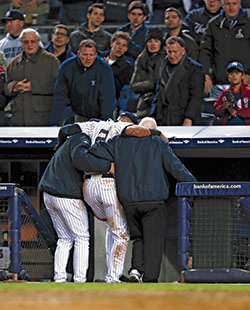
In the upper deck, just down the right-field line of Yankee Stadium, October 13 had just turned into October 14, but everyone around me was still screaming their faces off. That was about to change. In the top of the twelfth inning of Game One of the Yankees’ American League Championship Series against the Detroit Tigers, just 45 minutes after Raúl Ibañez had hit yet another home run to save the Yankees’ bacon, Tigers shortstop Jhonny Peralta hit a hard ground ball up the middle. It was a tough play for Derek Jeter—going to his left was never his strong suit, even when he was young—but he got to the ball … and crumpled.
Jeter’s left ankle, which had been strained because he had been rehabbing another leg injury, just gave, and Jeter went down with a scream. Because this was Derek Jeter, everyone expected him to pop back up: Derek Jeter always pops back up. But he didn’t. He stayed down. Later, we would learn Jeter had broken his ankle and would miss the rest of the postseason, but the crowd gave its own, instant diagnosis: It went silent. It was quieter inside Yankee Stadium at that moment than it had been five hours earlier, when I was one of about 400 in the building. Some 50,000 people shifted immediately from attending a baseball game to attending a morgue. The only sound was the sad whir of the blimp engine overhead, and blimp engines aren’t even very loud.
The Yankees wound up being swept in that series, of course, though the team’s fans knew, that night, that it was over. And they handled it the way you would want them to: reverently. For the rest of the evening, nobody tried to do the wave. Nobody danced to “Y.M.C.A.” Nobody began booing the Tigers. The place just shut down, in silent respect for the loss of the Yankees’ leader.
